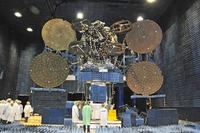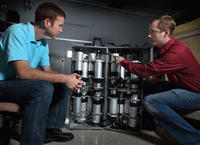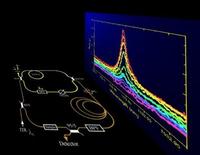-
Wi-Fi signals enable through-wall detection
Engineers prove the concept that local Wi-Fi signals can be used to monitor moving objects and bodies that are otherwise visually obscured. Although fundamentally similar to traditional radar systems, their novel approach is entirely passive — utilizing the wireless signals that already swamp our urban airways. This technology has a wide range of applications from healthcare monitoring, security and emergency disaster relief, to finding earthquake survivors in fallen buildings.
-
-
New app turns smartphones into sensors for an earthquake early-warning system
The MyShake app, still in test mode, uses smartphone accelerometers and locators to augment the data on incoming quakes issued by the 400 seismometers which are part of California’s ShakeAlert program.Registered phones act as additional earthquake sensors, as the app runs an algorithm which detects when the phone is still or shaking. Should several registered phones in the same area begin to shake at the same time, an earthquake alert is issued.
-
-
Generating fuel from sunlight
Researchers have made significant progress towards developing a process of Artificial Photosynthesis (AP) that could replace the use of fossil fuels in the future. AP is the industrial process of preparing fuels and chemicals from nothing more than carbon dioxide, water and sunlight. It is a vital process that would be the foundation of a world that would no longer need fossil fuels.
-
-
Boeing completes testing of new anti-jamming technology

Boeing says it has proven its new anti-jamming communications technology is capable of operating as either a ground-based user terminal or satellite-based networking hub, enabling the military to send and receive secure communications at a significantly lower cost by using existing terminals and satellites.
-
-
Cockroach cyborgs use microphones to detect, trace sounds in collapsed buildings
Researchers have developed technology that allows cyborg cockroaches, or biobots, to pick up sounds with small microphones and seek out the source of the sound. The technology is designed to help emergency personnel find and rescue survivors in the aftermath of a disaster. The researchers have also developed technology that can be used as an “invisible fence” to keep the biobots in the disaster area. “In a collapsed building, sound is the best way to find survivors,” says one of the researchers.
-
-
Mental-health apps may reduce number of mass shooting events
Between 1982 and 2011, mass shootings occurred every 200 days on average. S since 2011, mass shootings have occurred every sixty-four days on average. Mass shootings have one thing in common: the culprits all suffered from mental illness and the condition was known to at least one person. New mobile app educates the public about mental illness and provides local and national resources for early intervention and treatment.
-
-
Sandia Lab’s mobile neutron imager shines in urban emergency response exercise

A nuclear device has been hidden in a high-rise building in a major metropolitan area. Emergency responders have intelligence that narrows down the location to a single city block, but it is not safe to search door-to-door. Can they identify the exact location of the device quickly without the culprits realizing a search is on? The answer is a definite yes. Sandia Lab’ mobile imager of neutrons for emergency responders (MINER) system did just that at an emergency response exercise in downtown Chicago earlier this year. The exercise used a sealed laboratory radiation source that mimics the radioactive signature of more nefarious material.
-
-
New smart key software enhances security for homes businesses
Computer scientists and security specialists have created an innovative electronic smart key system that aims to provide a safer and more flexible security system for homes and businesses. eLOQ is a new software system for the creation and management of electronic keys and locks which cannot be copied or picked.
-
-
Students point to future of ocean robotics in new global game
College students from around the world demonstrated they could have a hand in shaping the future of ocean robotics as they competed in the first Maritime RobotX Challenge, which was held 24-26 October in Singapore. “Developing autonomy for surface vessels is still in its early stages, and these students have the opportunity to come up with solutions that could set new standards in this field,” said Assistant Chief of Naval Research Capt. Rob Palisin, who helped judge the competition. “In turn, the Navy gets the chance to observe the best young engineers in action and learn from their approaches.”
-
-
Next-generation technology for first responders: intuitive, instinctive, and interoperable
DHS’s Science and Technology Directorate (S&T) has a vision for a new age of first responders, a vision which will enable first responders and their technology to be more intuitive, instinctive, and interoperable.TheNext-Generation First Responder suit will incorporates wearables, the Internet, and cellular connectivity, along with multiple environmental and biological sensors to help firefighters, law enforcement, and aid workers, better perform their jobs safely.
-
-
Light frequencies help sniff out deadly materials from a distance

Spectroscopic chemical sensing, which measures the frequency of light absorbed or scattered from a substance to help determine its molecular identity, can be used to detect traces of biological and chemical agents and residue from explosive materials. New program aims to develop chip-sized, optical frequency combs which accurately identify even tiny traces of dangerous biological and chemical substances several football fields away.
-
-
Building a better lie detector
The Intelligence Advanced Research Projects Activity (IARPA), within the Office of the Director of National Intelligence (ODNI), announced the other day the winner of its first public challenge contest, Investigating Novel Statistical Techniques to Identify Neurophysiological Correlates of Trustworthiness (INSTINCT). The winning solution, JEDI MIND — Joint Estimation of Deception Intent via Multisource Integration of Neuropsychological Discriminators — uses a combination of innovative statistical techniques to improve predictions approximately 15 percent over the baseline analysis.
-
-
Fusion reactor concept could be cheaper than coal
Fusion energy almost sounds too good to be true — zero greenhouse gas emissions, no long-lived radioactive waste, a nearly unlimited fuel supply. Perhaps the biggest roadblock to adopting fusion energy is that the economics have not penciled out. Fusion power designs aren’t cheap enough to outperform systems that use fossil fuels such as coal and natural gas. University of Washington engineers hope to change that. They have designed a concept for a fusion reactor that, when scaled up to the size of a large electrical power plant, would rival costs for a new coal-fired plant with similar electrical output.
-
-
Sensor network will track down illegal bomb-making
Terrorists can manufacture bombs with relative ease, few aids, and easily accessible materials such as synthetic fertilizer. Security forces do not always succeed in preventing the attacks and tracking down illegal workshops in time. Bomb manufacturing, however, leaves its traces. A network of different sensors will detect illicit production of explosives and improvised explosive devices (IEDs). Traces on doorknobs, in sewage, or in the air will be detected by the sensors and the data will be fused in a command center.
-
-
Blackout? Robots can help
Big disasters almost always result in big power failures. Not only do they take down the TV and fridge, they also wreak havoc with key infrastructure like cell towers. That can delay search and rescue operations at a time when minutes count. Now, researchers have developed a tabletop model of a robot team that can bring power to places that need it the most. In addition to disaster recovery, their autonomous power distribution system could have military uses, particularly for Special Forces on covert missions.
-
More headlines
The long view
Encryption Breakthrough Lays Groundwork for Privacy-Preserving AI Models
In an era where data privacy concerns loom large, a new approach in artificial intelligence (AI) could reshape how sensitive information is processed. New AI framework enables secure neural network computation without sacrificing accuracy.
AI-Controlled Fighter Jets May Be Closer Than We Think — and Would Change the Face of Warfare
Could we be on the verge of an era where fighter jets take flight without pilots – and are controlled by artificial intelligence (AI)? US R Adm Michael Donnelly recently said that an upcoming combat jet could be the navy’s last one with a pilot in the cockpit.
AI and the Future of the U.S. Electric Grid
Despite its age, the U.S. electric grid remains one of the great workhorses of modern life. Whether it can maintain that performance over the next few years may determine how well the U.S. competes in an AI-driven world.
Using Liquid Air for Grid-Scale Energy Storage
New research finds liquid air energy storage could be the lowest-cost option for ensuring a continuous power supply on a future grid dominated by carbon-free but intermittent sources of electricity.
Enhanced Geothermal Systems: A Promising Source of Round-the-Clock Energy
With its capacity to provide 24/7 power, many are warming up to the prospect of geothermal energy. Scientists are currently working to advance human-made reservoirs in Earth’s deep subsurface to stimulate the activity that exists within natural geothermal systems.
Experts Discuss Geothermal Potential
Geothermal energy harnesses the heat from within Earth—the term comes from the Greek words geo (earth) and therme (heat). It is an energy source that has the potential to power all our energy needs for billions of years.
Autonomous Weapon Systems: No Human-in-the-Loop Required, and Other Myths Dispelled
“The United States has a strong policy on autonomy in weapon systems that simultaneously enables their development and deployment and ensures they could be used in an effective manner, meaning the systems work as intended, with the same minimal risk of accidents or errors that all weapon systems have,” Michael Horowitz writes.
Are We Ready for a ‘DeepSeek for Bioweapons’?
Anthropic’s Claude 4 is a warning sign: AI that can help build bioweapons is coming, and could be widely available soon. Steven Adler writes that we need to be prepared for the consequences: “like a freely downloadable ‘DeepSeek for bioweapons,’ available across the internet, loadable to the computer of any amateur scientist who wishes to cause mass harm. With Anthropic’s Claude Opus 4 having finally triggered this level of safety risk, the clock is now ticking.”
Autonomous Weapon Systems: No Human-in-the-Loop Required, and Other Myths Dispelled
“The United States has a strong policy on autonomy in weapon systems that simultaneously enables their development and deployment and ensures they could be used in an effective manner, meaning the systems work as intended, with the same minimal risk of accidents or errors that all weapon systems have,” Michael Horowitz writes.
Are We Ready for a ‘DeepSeek for Bioweapons’?
Anthropic’s Claude 4 is a warning sign: AI that can help build bioweapons is coming, and could be widely available soon. Steven Adler writes that we need to be prepared for the consequences: “like a freely downloadable ‘DeepSeek for bioweapons,’ available across the internet, loadable to the computer of any amateur scientist who wishes to cause mass harm. With Anthropic’s Claude Opus 4 having finally triggered this level of safety risk, the clock is now ticking.”
